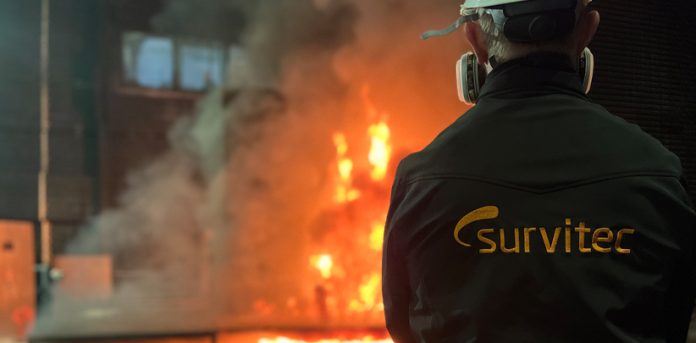A recent fire safety study conducted by Survitec, a provider of Survival Technology solutions, has uncovered shortcomings in traditional firefighting techniques for combating methanol-based fires on conventional vessels.
The study, which included extensive fire tests on dual-fuel marine engines using both diesel oil (DO) and methanol, comes amid increasing interest in methanol as a viable alternative marine fuel.
“Our tests confirm that traditional water mist fire suppression mechanisms do not perform as expected on methanol pool fires and methanol spray fires. A completely different approach is required if these ships are to remain safe,” stated Michał Sadzyński, product manager, Water Mist Systems, Survitec.
Methanol, a type of methyl alcohol (CH3OH), burns differently from hydrocarbon fuels and possesses a significantly lower flashpoint of 12°C (54°F). Despite established fire safety regulations and testing standards for diesel fuels, comprehensive test protocols for alcohol-based fuels like methanol and ethanol are still in development.
“We believe this is a high-risk situation that needs immediate action. Methanol fires are far more aggressive than fires involving traditional hydrocarbon fuels. Methanol fires have different physicochemical properties so they cannot be extinguished as easily or with the same approach,” stressed Sadzyński.
According to Survitec tests, water mist systems, which effectively absorb heat and displace oxygen in diesel fires, do not yield the same results in methanol fires. This suggests that retrofitting existing vessels to use methanol would necessitate a complete overhaul and redesign of their fixed firefighting systems.
For bilge areas, IMO MSC.1/Circ.1621 mandates an approved alcohol-resistant foam system for ships utilizing methanol. Notably, this is the first time that the rules require a fixed, low-expansion foam system to protect machinery space bilges.
“Our tests demonstrate that standard discharge devices do not properly extinguish methanol pool fires in the confined bilge space. It is crucial to deliver properly expanded foam on the methanol pool fire and this is not an easy task within such a narrow space where throw length is limited. MSC.1/Circ.1621 provides us with a starting guideline but it is very general and therefore open to interpretation. Moreover, methanol compliance for Local Application Firefighting (LAFF) systems is not yet covered. As an industry, we need to come together and develop comprehensive and robust fire test standards and safety rules tailored to methanol’s unique properties,” explained Maciej Nieścioruk, product manager, of Foam Systems, Survitec.
The investigation’s clear findings come at a time when orders for methanol-fueled vessels are on the rise. This greener fuel is viewed as a solution for meeting the industry’s emissions reduction goals, with forecasts indicating a rapid increase in adoption rates.
Over the past 12 months, orders for methanol-fueled new builds have increased by 9%, surpassing those for LNG-fueled ships by 2%. Analysts project that the methanol-fueled fleet will reach 20 million gross tons by 2028.
“We are seeing a significant uptake in orders for methanol-fuelled vessels, with 2023 being the breakout year for this alternative marine fuel. With more methanol-powered ships being built every year, the industry must act now to prevent dangerous gaps in fire safety,” mentioned Nieścioruk.







